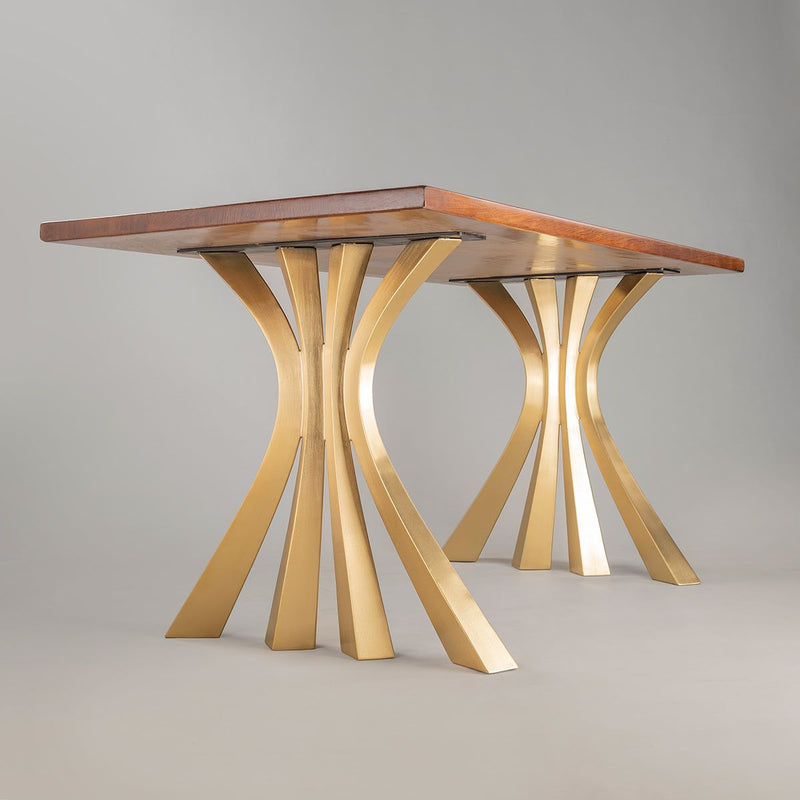Just how to Choose the Perfect Dining Room Table Legs for Your Home Design
Just how to Choose the Perfect Dining Room Table Legs for Your Home Design
Blog Article
A Detailed Check Out Eating Table Leg Styles: Discovering the Ideal Match
Picking the ideal table leg style is critical for both visual appeal and practical capability. Standard four legs offer classic sophistication and stability, while the stand base supplies enhanced legroom and a modern appearance. For those with larger tables, trestle legs make certain strong support, whereas barrette legs introduce a mid-century modern-day vibe with their minimalist style. The x-shaped legs blend modern style with boosted stability. Each of these alternatives brings special benefits, making the option greater than simply a matter of choice. Explore better to discover which design perfectly enhances your dining area and lifestyle.
Traditional Four Legs
Amongst the numerous kinds of eating table leg styles, the conventional four-leg design remains a timeless choice for many houses. 4 legs supply balanced support, ensuring the table remains secure and qualified of bearing substantial weight (dining room table legs).
From an aesthetic viewpoint, the typical four-leg layout can be quickly adapted to numerous indoor styles. Whether crafted from wood, steel, or a combination of materials, these legs can be delicately sculpted, smooth and minimalistic, or anything in between. Their versatility permits them to match both rustic and contemporary setups seamlessly.
Moreover, the uncomplicated structure of the four-leg design promotes simplicity of movement and positioning within a space. Unlike even more complicated bases, this design minimizes blockages, offering sufficient legroom for diners. In recap, the traditional four-leg table leg design marries enduring style with functional functionality, making it a sharp choice for those seeking both type and feature in their eating furniture.
Stand Base
Commonly commemorated for its sophisticated and space-efficient layout, the stand base is a distinguished option to the typical four-leg configuration in table leg styles. This unique base generally features a single central column supporting the tabletop, which can differ in type, from ornately sculpted wood to smooth, modern-day steel. Among the primary benefits of the pedestal base is its capability to make best use of legroom and seating versatility. Without edge legs, diners are afforded greater flexibility of movement, making it a suitable choice for round and oval tables that advertise more intimate and comprehensive events.
Moreover, the stand base's central assistance can manage significant weight, enabling making use of heavier tabletops, such as marble or thick wood. This toughness combined with its visual convenience makes the stand base a preferred option in both conventional and modern interior settings. It can perfectly integrate with different design styles, from classic elegance to minimalist modernity. Additionally, the central column itself supplies a canvas for complex styles and imaginative expressions, adding an element of aesthetic interest beneath the table. In summary, the stand base combines functionality snappy, making it an improved and sensible option for diverse dining settings.
Trestle Legs
Trestle legs provide a durable and timeless structure for dining tables, defined by their straight cross-bracing and durable assistance beams. Originating from middle ages times, this design has actually advanced yet preserved its important framework, making it a perennial fave in both conventional and modern settings. The main trestle beam, frequently sustained by 2 or even more vertical blog posts, supplies phenomenal stability, permitting bigger table lengths without the requirement for added legs.
A considerable benefit of trestle leg tables is the adequate legroom they offer. Unlike tables with 4 corner legs, the absence of obstructions at the table's sides gives unobstructed space for chairs and diners, improving comfort and accessibility. This makes trestle tables optimal for accommodating bigger events, whether in a dining-room or a reception hall.
The visual adaptability of trestle legs is significant. Offered in find out here a range of materials such as timber, metal, and composite, they can be ended up to complement a variety of indoor designs. From rustic farmhouse to sleek modern designs, trestle legs can be personalized to fit individual tastes. Their enduring appeal and useful benefits make trestle legs a compelling option for those looking for both style and functionality in their table.
Barrette Legs

The allure of barrette legs hinges on their simpleness and convenience - dining room table legs. Available in a series of materials, including steel and brass, they can be ended up in various shades to enhance different interior designs. Whether coupled with a rustic wooden tabletop or a modern glass surface area, barrette legs effortlessly blend capability with a touch of classic beauty
Sturdiness is another remarkable attribute of hairpin legs. Regardless of their delicate look, these legs try this out are crafted to birth substantial weight, guaranteeing the table stays secure and secure. Additionally, they are relatively simple to set up, making them a prominent option for do it yourself fanatics and specialist furnishings manufacturers alike.
X-Shaped Legs

Created from materials such as steel, wood, or a mix of both, X-shaped legs can be tailored to match different layout preferences. Steel legs commonly lend a smooth and commercial feeling, ideal for loft-style apartment or condos and modern dining areas. On the various other hand, wooden X-shaped legs provide a warmer, extra rustic appeal, appropriate for farmhouse or diverse insides. The versatility in materials enables home owners to customize their dining tables to much better fit their total layout scheme.
In addition, the design behind X-shaped legs ensures even weight distribution, reducing the danger of wobbling and improving toughness. This makes them specifically fit for bigger eating tables that call for added assistance. Fundamentally, X-shaped legs mix sensible design with modern-day visual appeals, making them an ageless option for varied eating environments.
Conclusion
A thorough understanding of eating table leg styles discloses the unique qualities and advantages of each style. Trestle legs guarantee durable support for bigger tables, and barrette legs introduce a mid-century modern-day aesthetic.
Report this page